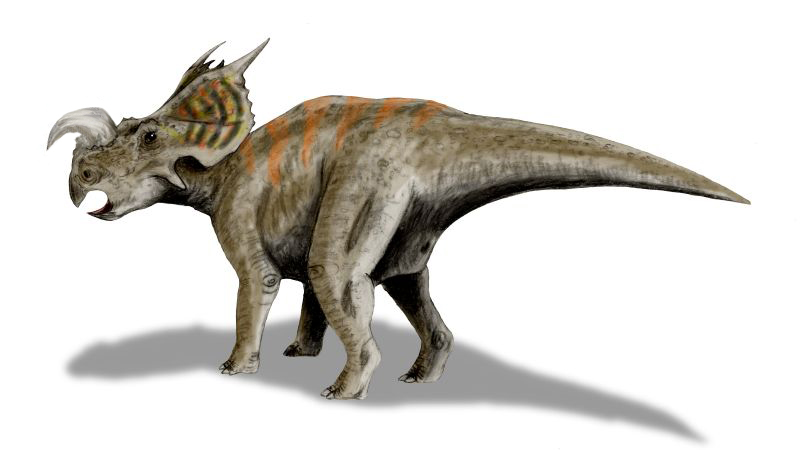- Einiosaurus
Taxobox
name = "Einiosaurus"

image_width = 250px
image_caption =
regnum =Animal ia
phylum = Chordata
classis = Sauropsida
superordo =Dinosaur ia
ordo =Ornithischia
familia =Ceratopsidae
subfamilia =Centrosaurinae
genus = "Einiosaurus"
genus_authority = Sampson, 1995
subdivision_ranks =Species
subdivision = "E. procurvicornis" Sampson, 1995 (type)"Einiosaurus" is a medium-sized centrosaurine (“short-frilled”)
ceratopsian from the UpperCretaceous (Campanian)Two Medicine Formation of northwesternMontana . The generic epithet means 'buffalo lizard', in a combination ofBlackfeet Indian and LatinizedAncient Greek and the specific epithet means 'forward-curving horn' inLatin and Ancient Greek.Fossil Material
"Einiosaurus" is an exclusively Montanan
dinosaur , and all its known remains are currently held at theMuseum of the Rockies in Bozeman, Montana. At least 15 individuals of varying ages are represented by three adult skulls and hundreds of other bones from two low-diversity (in species) bonebeds, which were discovered by Jack Horner in 1985 and excavated from 1985 - 1989 byMuseum of the Rockies field crews. These bonebeds were originally thought to contain a new species of "Styracosaurus " and are referred to as such in the comprehensive taphonomic study by Ray Rogers (1990).Description
In 1995 Scott D. Sampson formally described and named "Einiosaurus procurvicornis" from this material, as well as "
Achelousaurus horneri", also from a bonebed in this region. "Einiosaurus" is typically portrayed with a low, strongly forward-curving nasal horn that resembles a bottle opener, though this may only occur in some adults. Supraorbital (over-the-eye) horns are low and rounded if present at all, as opposed to ceratopsids with prominent supraorbital horns such as "Triceratops ". A pair of large spikes projects backwards from the relatively small frill.Taphonomy andpaleobiology Low-diversity and monospecific bonebeds are thought to represent herds that may have died catastrophically, such as during a drought or flood. This is evidence that "Einiosaurus", as well as other centrosaurine ceratopsians such as "
Pachyrhinosaurus " and "Centrosaurus ", were gregarious, herding animals similar in behavior to modern-daybison orwildebeest . In contrast, chasmosaurine (“long-frilled”) ceratopsids, such as "Triceratops " and "Torosaurus ", are typically found singly, implying that they may have been somewhat solitary in life, though fossilized footprints may provide evidence for the contrary."Einiosaurus" was a herbivorous dinosaur and grew to 6 meters in length. Like all ceratopsids, it had a complex dental battery capable of processing even the toughest plants. Contemporaneous dinosaurs include the basal
ornithopod "Orodromeus ", thehadrosaurids "Hypacrosaurus ", "Maiasaura ", and "Prosaurolophus ";ankylosaurs "Edmontonia " and "Euoplocephalus ", thetyrannosaurid "Daspletosaurus " (which appears to have been a specialist of preying on ceratopsians), as well as the smaller theropods "Bambiraptor ", "Chirostenotes ", "Troodon ", and "Avisaurus "; and theceratopsid s "Brachyceratops " and "Achelosaurus ". "Einiosaurus" lived in a climate that was seasonal, warm, and semi-arid. Other fossils found with the "Einiosaurus" material include freshwaterbivalves andgastropods , which imply that these bones were deposited in a shallow lake environment.Phylogeny The placement of "Einiosaurus" within
Centrosaurinae is problematic due to the transformational nature of several of its skull characters, and its closest relatives are either "Centrosaurus " and "Styracosaurus " or "Achelousaurus " and "Pachyrhinosaurus ". The latter hypothesis is supported by Horner "et al." (1992), where "Einiosaurus" is the earliest of a transformational series in which the nasal horns gradually change to rugose bosses, as in "Achelousaurus" and "Pachyrhinosaurus" who are the second and third in this series. The frills also grow in complexity.Regardless of which hypothesis is correct, "Einiosaurus" appears to occupy an intermediate position with respect to the
evolution of the centrosaurines.References
*Dodson, P., C.A. Forster, and S.D. Sampson. 2004. "Ceratopsidae" in Weishampel, D.B., P. Dodson, and H. Osmolska (eds.) "The Dinosauria". 2nd Edition, University of California Press.
*Horner, J.R., D.J. Varricchio, and M.J. Goodwin. 1992. "Marine transgressions and the evolution of Cretaceous dinosaurs". "Nature" 358:59-61.
*Rogers, R.R. 1990. "Taphonomy of three dinosaur bone beds in the Upper Cretaceous Two Medicine Formation of northwestern Montana: evidence for drought-related mortality". "Palaios" 5:394-413.
*Sampson, S.D. 1995. "Two new horned dinosaurs from the Upper Cretaceous Two Medicine Formation of Montana; with a phylogenetic analysis of the Centrosaurinae (Ornithischia: Ceratopsidae)". "J. Vert. Paleontol." 15(4):743-760.External links
* [http://www.dinodata.org/index.php?option=com_content&task=view&id=6517&Itemid=67 "Einiosaurus"] at DinoData
* [http://www.isgs.uiuc.edu/dinos/de_4/5a7954a.htm "Einiosaurus", from the Dinosaur Encyclopaedia] at Dino Russ's Lair
Wikimedia Foundation. 2010.
